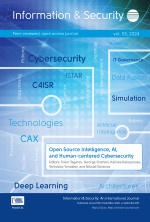Trajectory Data Compression Using Speed-Course Threshold Followed by Adaptive Douglas-Peucker Algorithm
Source:
Information & Security: An International Journal,Keywords:
Automatic identification system, Douglas-Peucker algorithm, handling patterns, sliding window, trajectory compressionAbstract:
Storing raw vessel trajectory data in a database is inefficient due to its massive size, which makes data processing and analysis challenging. As a solution, many compression methods are offered with their benefits and drawbacks. This article proposes a real-time (online) compression algorithm applied while the ship is sailing. The aim is to simplify the original trajectory data by using a buffer to store temporary trajectory data that exceed the vessel’s information (speed and course) thresholds. Then, after some data is entered and stored in the buffer, the Adaptive Douglas-Peucker algorithm is applied to further increase the compression ratio each time the buffer is full. SCT-ADP, the name of the proposed algorithm, has not been evaluated due to the time available for this research. However, because the structure of the proposed algorithm is based on two existing algorithms, we estimate its advantages and disadvantages in the discussion section. In a follow on research, we will evaluate more rigorously the pros and cons of implementing the SCT-ADP algorithm.
